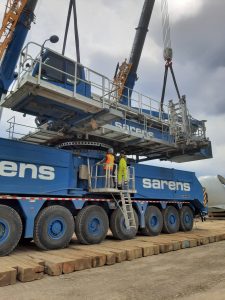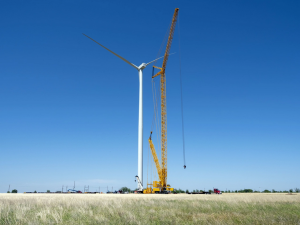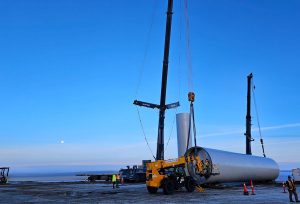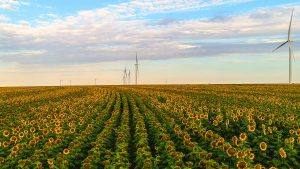Some are well over 100 metres in height; they weigh more than 150 tons each.
Power from the wind turbines now standing tall on Alberta’s Buffalo Plains was delivered to the province’s electrical grid for the first time last month, marking a significant milestone for the country, for a Toronto-based construction company working on the project, and for thousands of companies and customers using Amazon’s cloud computing services.
Located on 17,500 acres of privately owned farmland just west of Lamonde, AB, 83 turbines with an approximate total energy capacity of 495 megawatts (MW) are being installed, making the Buffalo Plains Wind Farm the largest onshore wind farm in Canada.
But with new directions coming from the provincial government, it may be the last large renewable energy project in Alberta.
The first turbine on Buffalo Plains was installed last April and more than a third of the wind turbines are now up. The remaining installation work should be completed this year, followed by full grid connection.
Toronto-based Borea Construction, a leading renewable energy construction company, is handling construction on the estimated $642-million project, in collaboration with turbine manufacturer Siemens Gamesa.
(A German energy company, ABO Wind – now ABO Energy – was the project’s original owner; ABO sold the project to Danish investment firm Copenhagen Infrastructure Partners in 2022, and it was CIP that made the announcement that clean renewable power was flowing to the provincial grid.)
“We are very pleased to have reached this important project milestone on Buffalo Plains,” said Copenhagen’s Tim Evans, partner and head of CIP North America. He said the first successful power deliveries from the large and complex infrastructure projects shows it can provide local jobs and clean, renewable wind energy for many years to come.
The wind farm will make use of a combination of Siemens Gamesa wind turbines, including its SG6.0-170 model (rated at 6.6 MW), with a 110.5-metre hub height and 170-metre blade rotor diameter, and the SG5.0-145 (5.2 MW), with its 95.5-metre hub height and 145-metre diameter.
Modern wind turbines have three components: the tower, the rotor consisting of three blades, and the nacelle. The hub transmits the rotational movement of the rotor blades inside the nacelle, where the generator transforms the kinetic energy into electricity. The electricity is transferred through underground cables to a substation where the voltage is stepped up to transmission level voltage.

Heavy lifting tasks encountered at Buffalo Plains go to Sarens Canada, which will offload and install dozens of large turbines.
The heavy lifting tasks encountered on Buffalo Plains go to Sarens Canada Inc., which has the commission to offload and install dozens of large turbines: The 110-metre-high 6.0-170 wind turbine weighs 149.4 tons, and the 5.0-145 weighs 152.4 tons. (While Siemens has provided its turbines for other Canadian renewable projects, the manufacturer has faced some headwinds recently over turbine flaws in other of its models.)

Giant lattice boom cranes mounted on truck chassis are used to lift huge wind turbines.
Sarens, a Belgium-based multinational construction firm, set up shop in Canada in 2011, with the acquisition of Canada Crane Services Inc. Today, Sarens Canada supplies mobile construction cranes and heavy lift solutions, as well as engineered transport services, from offices across the country.
The engineering team and project staff of 52 workers used giant cranes and ‘boom boosters’ for the various strong lifting-at-height requirements on the Buffalo Plains project. The giant LG-1750, for example, is a lattice boom crane mounted on an eight-axle truck chassis. Its max lift height is 193 metres and its lift capacity is 750 tonnes.
At Buffalo Plains, the turbines connect to a 34.5 kilovolt underground and above ground collector system, accompanied by fibre optic cabling. They are interconnected to the grid through a roughly 12 to 15 km transmission line, set up in consultation with the Alberta Electric System Operator (AESO).

The installation at Buffalo Plains has an estimated 20-to-25-year operational life, after which the project must be decommissioned or refurbished.
The installation at Buffalo Plains has an estimated 20-to-25-year operational life, after which the project must be decommissioned or refurbished. Decommissioning of the turbines and returning the land use to its prior state is a standard condition of the project approval with the Alberta Utilities Commission, as well as a contractual obligation with the host landowners. CIP says that, thanks to the economics and sustainability of wind resource extraction, it hopes to keep the project going past its initially proposed life span.
The region first sought regulatory approval for the Buffalo Plains project in January 2021, saying it could generate some 30 per cent of its total tax base. Before the province’s renewable energy moratorium and subsequent grid reorganization took effect, reports show the region could collect about $8.3 million per year by 2028.
It received Alberta Utility Commission (and municipal) approvals and was expected to create around 250 jobs during construction phase, with 15 permanent jobs expected after becoming operational.
Earlier this year, however, the provincial utilities regulator was directed by Alberta Premier Danielle Smith to use a new “Agriculture First” evaluation plan to review renewable power project applications for private and federal land. The new approach could restrict and even ban renewable power projects near agriculture; while other proposed clean energy developments could well be impacted, the Buffalo Plains onshore wind project isn’t affected by the changes.
Which is good news for Jeff Bezos.
In November 2023, Amazon (Bezos is Amazon’s founder, executive chairman, and former CEO) announced an investment into the project to offset its emissions, and the Seattle-based company has also signed a power purchase agreement to get 415 MW from Buffalo Plains to power its local cloud operations, including an Amazon Web Services (AWS) Canada West (Calgary) data centre and related fulfillment centres.
Economic research studies estimate that AWS will invest more than $24 billion in its technology infrastructure in Canada over the next decade or so, and its power-hungry cloud service is a big reason for those investment plans.
# # #

Amazon Web Services says it will invest more than $24 billion in its infrastructure in Canada over the next decade or so, and its power-hungry cloud service is a big part of those investment plans. Amazon wind farm image.
-30-



